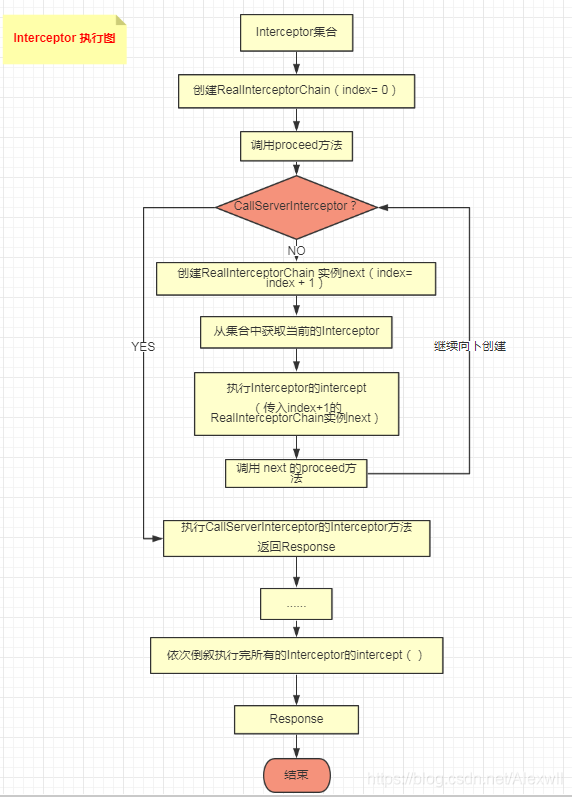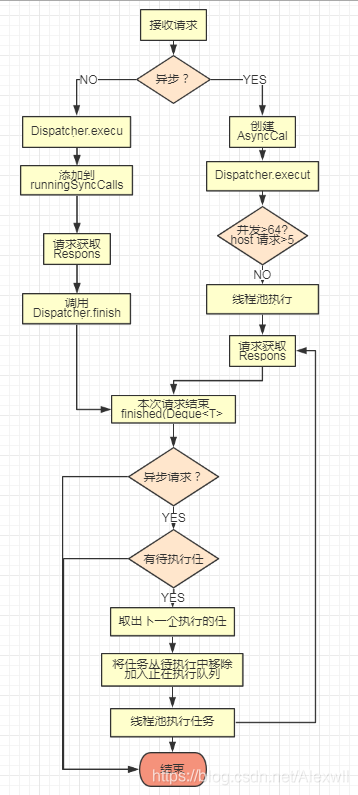1、OkhttpClient创建
- 创建OkhttpClient
OkHttpClient okHttpClient = new OkHttpClient.Builder().build();
- OkHttpClient.Builder:配置并创建OkhttpClient
public Builder() {
dispatcher = new Dispatcher(); //
protocols = DEFAULT_PROTOCOLS; //默认支持的Http协议版本
connectionSpecs = DEFAULT_CONNECTION_SPECS; //OKHttp连接(Connection)配置
eventListenerFactory = EventListener.factory(EventListener.NONE); //Call状态监听器
proxySelector = ProxySelector.getDefault(); //使用默认的代理选择器
cookieJar = CookieJar.NO_COOKIES;//Cookie管理类,保存和添加Cookie,默认是没有Cookie的
socketFactory = SocketFactory.getDefault(); //默认的Socket工厂产生Socket
hostnameVerifier = OkHostnameVerifier.INSTANCE;
certificatePinner = CertificatePinner.DEFAULT;
proxyAuthenticator = Authenticator.NONE;
authenticator = Authenticator.NONE;
connectionPool = new ConnectionPool(); //连接池
dns = Dns.SYSTEM; //域名解析系统 domain name -> ip address;
followSslRedirects = true;
followRedirects = true;
retryOnConnectionFailure = true;
connectTimeout = 10_000;
readTimeout = 10_000;
writeTimeout = 10_000;
pingInterval = 0;
}
总结OkHttpClient.Builder的配置如下:
- 创建默认任务调度器Dispatcher
- 创建Cookie管理类,保存和添加Cookie
- 默认的Socket工厂,产生Socket并连接使用
- 配置连接池ConnectionPool
- 配置重试、读写超时等
2、构建请求Request
- 创建Request实例
Request request = new Request.Builder().url("").build();
- 源码
public Builder() { // 创建Builder
this.method = "GET";
this.headers = new Headers.Builder(); // 初始化Headers.Builder实例用于设置请求头
}
public Builder addHeader(String name, String value) { // 设置请求头
headers.add(name, value);
return this;
}
public Builder url(String url) { // 保存并设置URL
if (url.regionMatches(true, 0, "ws:", 0, 3)) {
url = "http:" + url.substring(3);
} else if (url.regionMatches(true, 0, "wss:", 0, 4)) {
url = "https:" + url.substring(4);
}
return url(HttpUrl.get(url));
}
public Request build() {
if (url == null) throw new IllegalStateException("url == null");
return new Request(this); // 将Builder拼接的信息保存在Request中
}
- 代码执行的逻辑:
- 创建Request.Builder()对象,保存请求方法并初始化Headers.Builder对象
- 调用Builder的 url()和 addHeader()设置请求的地址和请求头Header
- 调用Builder的build()方法创建Request对象,将参数信息封装到Request中
3、RealCall执行网络请求
3.1、 execute:同步请求
@Override public Response execute() throws IOException {
synchronized (this) {
if (executed) throw new IllegalStateException("Already Executed”);//每个请求只能执行一次
executed = true;
}
captureCallStackTrace();
eventListener.callStart(this); // 开始请求状态回调
try {
client.dispatcher().executed(this); //调用调度器dispatcher将RealCall加入正在执行的任务,
Response result = getResponseWithInterceptorChain(); //执行网络请求并返回Response
if (result == null) throw new IOException("Canceled");
return result;
} catch (IOException e) {
eventListener.callFailed(this, e); // 请求失败回调
throw e;
} finally {
client.dispatcher().finished(this); //本次请求结束,继续执行未执行完成的异步任务
}
}
总结execute执行过程:
- 首先判断当前Call实例是否执行过,每个请求只能执行一次
- execute()方法中首先根据监听listener回调网络请求状态开始
- 使用任务调度器执行Call,将此Call加入调度器的执行队列中,然后调用所有设置的拦截器依次执行,此方法也是Okhttp中的关键部分
- 在方法执行后调用任务调度器finished()方法结束此次任务,并继续是否有其他任务执行
- getResponseWithInterceptorChain():使用拦截器策略处理网络请求
Response getResponseWithInterceptorChain() throws IOException {
List<Interceptor> interceptors = new ArrayList<>();
interceptors.addAll(client.interceptors()); // 添加Client中设置的拦截器
interceptors.add(retryAndFollowUpInterceptor); //
interceptors.add(new BridgeInterceptor(client.cookieJar())); //
interceptors.add(new CacheInterceptor(client.internalCache())); //缓存连接器
interceptors.add(new ConnectInterceptor(client)); //连接拦截器
if (!forWebSocket) {
interceptors.addAll(client.networkInterceptors()); //添加网络连接器
}
interceptors.add(new CallServerInterceptor(forWebSocket)); //
Interceptor.Chain chain = new RealInterceptorChain(interceptors, null, null, null, 0,
originalRequest, this, eventListener, client.connectTimeoutMillis(),
client.readTimeoutMillis(), client.writeTimeoutMillis());
return chain.proceed(originalRequest);
}
在getResponseWithInterceptorChain()执行:
- 创建Interceptor的集合,将用户设置的和连接所必须的Interceptor都添加到集合中
- 将Interceptor集合和配置参数封装到RealInterceptorChain中,此时index从0开始调用执行
- 依次调用chain.proceed(originalRequest),执行所有拦截器的interceptor,执行结束后获取并依次向上返回的Response,通过执行所有的interceptor完成整个网络请求
- RealInterceptorChain
public Response proceed(Request request, StreamAllocation streamAllocation, HttpCodec httpCodec,
RealConnection connection) throws IOException {
......
// 创建新的RealInterceptorChain实例,下标指向下一个Interceptor
RealInterceptorChain next = new RealInterceptorChain(interceptors, streamAllocation, httpCodec,
connection, index + 1, request, call, eventListener, connectTimeout, readTimeout,
writeTimeout);
Interceptor interceptor = interceptors.get(index); // 获取第一个执行的Interceptor
Response response = interceptor.intercept(next); //调用Interceptor的intercept()执行
......
return response;
}
}
Okhttp通过RealInterceptorChain类中的方法实现Interceptor的链式调用,这个地方可能会有疑问,如何把所有的Interceptor连接起来执行的,这里有点类似于递归的意思:
- getResponseWithInterceptorChain()中创建第一个RealInterceptorChain实例chain,此时传入index = 0 ,调用chain.proceed()
- 在chain的proceed()中又创建了index = 1的RealInterceptorChain实例next,并取出第一个拦截器执行intercept()
- 执行第一个拦截器的intercept(next),在intercept()中会调用传入next的proceed(),next实例的proceed()方法中,根据传入的index(此时为1)获取第二个拦截器,并创建第二个next2实例传入index = 2
- 执行第二个拦截器的intercept(next2),在拦截器的intercept()中会调用传入next2的proceed(),继续获取第三个拦截器并创建next3
- 。。。。。。。
- 直到拦截器结束,最后一个拦截器是CallServerInterceptor,它发起网络连接和请求并获的返回的Response
- 获取到Response后,倒数第二个拦截器继续执行结束,将Response回传到倒数第三个,依次向上回传直到,第一个拦截器
- 拦截器执行流程图:

3.2、 enqueue:异步请求
@Override public void enqueue(Callback responseCallback) {
synchronized (this) {
if (executed) throw new IllegalStateException("Already Executed");
executed = true;
}
captureCallStackTrace();
eventListener.callStart(this); // 状态回调
// 使用Callback创建AsyncCall,调用dispatcher调度器执行AsyncCall,先将AsyncCall加入异步执行队列然后依次执行任务
client.dispatcher().enqueue(new AsyncCall(responseCallback));
}
@Override protected void execute() { // AsyncCall中execute()
boolean signalledCallback = false;
try {
Response response = getResponseWithInterceptorChain(); //执行拦截器
if (retryAndFollowUpInterceptor.isCanceled()) {
signalledCallback = true;
responseCallback.onFailure(RealCall.this, new IOException("Canceled"));
} else {
signalledCallback = true;
responseCallback.onResponse(RealCall.this, response);
}
} catch (IOException e) {
if (signalledCallback) {
} else {
eventListener.callFailed(RealCall.this, e);
responseCallback.onFailure(RealCall.this, e);
}
} finally {
client.dispatcher().finished(this); //执行结束,继续执行下一个任务
}
}
总结:
1.异步执行时首先创建AsyncCall实例,并调用任务调度器执行AsyncCall
2. 调度器最终会执行到AsyncCall中的execute(),在execute()中和同步请求一样执行所有的拦截器
4、调度器:Dispatcher
- 属性
private int maxRequests = 64; // 默认支持最大的并发请求是64个
private int maxRequestsPerHost = 5; //单个Host最多执行5个并发请求
/** 任务执行的线程池. */
private @Nullable ExecutorService executorService;
executorService = new ThreadPoolExecutor(0, Integer.MAX_VALUE, 60, TimeUnit.SECONDS,
new SynchronousQueue<Runnable>(), Util.threadFactory("OkHttp Dispatcher", false));
/** 待执行异步任务的队列*/
private final Deque<AsyncCall> readyAsyncCalls = new ArrayDeque<>();
/** 正在执行异步任务的队列*/
private final Deque<AsyncCall> runningAsyncCalls = new ArrayDeque<>();
/** 正在执行的同步任务的队列*/
private final Deque<RealCall> runningSyncCalls = new ArrayDeque<>();
Dispatcher默认支持最大的并发请求是64个,单个Host最多执行5个并发请求,如果超过,则Call会先被放入到readyAsyncCall中,当出现空闲的线程时,再将readyAsyncCall中的线程移入到runningAsynCalls中执行请求,具体的属性见上面的注释;
- executed / enqueue
synchronized void executed(RealCall call) { // 同步请求
runningSyncCalls.add(call); // 添加到保存正在执行任务的队列中
}
synchronized void enqueue(AsyncCall call) { // 异步请求,根据现在请求数量是否超过限制去决定处理方式
if (runningAsyncCalls.size() < maxRequests && runningCallsForHost(call) < maxRequestsPerHost) {
runningAsyncCalls.add(call); // 添加到保存正在执行任务的队列中
executorService().execute(call); // 调用线程池执行execute()
} else {
readyAsyncCalls.add(call); // 正在执行的任务达到上限时,添加到保存准备执行任务的队列中
}
}
总结:
- 同步执行的直接将Call加入到同步队列runningSyncCalls中
- 异步请求的先判断当前请求的总数是否超过64,或当前host的请求是否超过5个,如果符合要求则调用线程池执行Call,并加入runningAsyncCalls队列
- 如果不满足上述条件,则将Call加入异步任务readyAsyncCalls等待执行
- 按照上面分析的Call的执行过程执行程序,执行结束后回调client.dispatcher().finished(this)
- client.dispatcher().finished(this):请求结束都调用
void finished(AsyncCall call) { //异步请求结束
finished(runningAsyncCalls, call, true); // true
}
void finished(RealCall call) { //同步请求结束
finished(runningSyncCalls, call, false); // false
}
private <T> void finished(Deque<T> calls, T call, boolean promoteCalls) {
int runningCallsCount;
Runnable idleCallback;
synchronized (this) {
if (!calls.remove(call)) throw new AssertionError("Call wasn't in-flight!”); //首先移除执行完成的Call
if (promoteCalls) promoteCalls(); // 如果是异步请求调用 promoteCalls()继续执行下一个Call
runningCallsCount = runningCallsCount();
idleCallback = this.idleCallback;
}
if (runningCallsCount == 0 && idleCallback != null) {
idleCallback.run();
}
}
在同步请求结束时,调用finish()将当前任务从队列中移除;在异步请求结束,调用finish()将当前任务从队列中移除,然后执行promoteCalls()继续执行ready中的Call
- promoteCalls(): 从ready的集合中获取任务Call执行,知道满足执行任务的最大上限
private void promoteCalls() {
if (runningAsyncCalls.size() >= maxRequests) return; // 如果超多最大请求直接返回
if (readyAsyncCalls.isEmpty()) return; // 如果没有待执行任务 return
for (Iterator<AsyncCall> i = readyAsyncCalls.iterator(); i.hasNext(); ) {
AsyncCall call = i.next(); // 取出下一个任务
if (runningCallsForHost(call) < maxRequestsPerHost) {
i.remove(); // 移除队列中的任务
runningAsyncCalls.add(call); // 加人物加入正在执行的队列
executorService().execute(call); // 执行任务
}
if (runningAsyncCalls.size() >= maxRequests) return;
}
}
promoteCalls()执行:
- 首先判断正在执行的任务数量是否超过上限
- 判断ready中是否有要执行的任务Call
- 遍历取出ready队列中的任务执行并加入running队列中,直到符合最大上限
- Dispatcher调度流程图

5、拦截器Interceptor
5.1、RetryAndFollowUpInterceptor:重试拦截器
作为系统的第一个拦截器,按照前面拦截器的工作原理,此处最终获取到执行结果,如果执行结果失败后发起重试和重定向功能,那整个流程会再次发起请求;
while (true) {
Response response = null;
boolean releaseConnection = true; //将标识位设置true
try { // (1)发起请求获取返回值
response = ((RealInterceptorChain) chain).proceed(request, streamAllocation, null, null);
releaseConnection = false; //请求成功会设置flase
} catch (RouteException e) {//捕获异常
if (!recover(e.getLastConnectException(), false, request)) {//判断是否可以重试,否则抛出异常
throw e.getLastConnectException();
}
releaseConnection = false; //请求成功会设置flase
continue; //跳过本次发起重试
} catch (IOException e) {
boolean requestSendStarted = !(e instanceof ConnectionShutdownException);
if (!recover(e, requestSendStarted, request)) throw e;
releaseConnection = false;
continue;
} finally {
if (releaseConnection) { //如果请求失败且不能重试,则关闭并释放资源
streamAllocation.streamFailed(null);
streamAllocation.release();
}
}
- .recover()判断是否发起重试,具体判断情况见注释
//尝试从与服务器通信失败中恢复,如果可恢复返回true,否则返回false
private boolean recover(IOException e, boolean requestSendStarted, Request userRequest) {
streamAllocation.streamFailed(e);
// (1)okhttpClient配置时是否设置了禁止重试
if (!client.retryOnConnectionFailure()) return false;
// (2)不是上面捕获的异常,且请求的内容被 UnrepeatableRequestBody 标记,
if (requestSendStarted && userRequest.body() instanceof UnrepeatableRequestBody) return false;
// (3)异常是致命的
if (!isRecoverable(e, requestSendStarted)) return false;
// (4)没有尝试的路线了(调用RouteSelector.hasNext()判断是否有尝试路线)
if (!streamAllocation.hasMoreRoutes()) return false;
return true;
}
- 执行重定向,根据执行结果返回的状态码构建重新请求
Request followUp;
try {
followUp = followUpRequest(response, streamAllocation.route()); // (1)根据错误的状态码,设置新的请求Request
} catch (IOException e) {
streamAllocation.release();
throw e;
}
if (followUp == null) { // 不需要重定向直接返回
streamAllocation.release();
return response;
}
if (++followUpCount > MAX_FOLLOW_UPS) { //(2)校验重试次数是否超过20次
streamAllocation.release();
throw new ProtocolException("Too many follow-up requests: " + followUpCount);
}
if (followUp.body() instanceof UnrepeatableRequestBody) { // 是否被UnrepeatableRequestBody包裹
streamAllocation.release();
throw new HttpRetryException("Cannot retry streamed HTTP body", response.code());
}
if (!sameConnection(response, followUp.url())) { // (3)比较重定向的Request和原来的是否一致,重定向后基本不会一样
streamAllocation.release();
streamAllocation = new StreamAllocation(client.connectionPool(), //(4)重新创建StreamAllocation实例
createAddress(followUp.url()), call, eventListener, callStackTrace);
this.streamAllocation = streamAllocation;
}
request = followUp;
priorResponse = response;
response = ((RealInterceptorChain) chain).proceed(request, streamAllocation, null, null); //(4)重新执行请求
- followUpRequest():根据请求返回的状态码,修改Request实现重定向再次发起请求
private Request followUpRequest(Response userResponse, Route route) throws IOException {
int responseCode = userResponse.code(); //获取Response的响应码Code
final String method = userResponse.request().method(); //获取请求方法method
switch (responseCode) {
case HTTP_PERM_REDIRECT:
case HTTP_TEMP_REDIRECT:
if (!method.equals("GET") && !method.equals("HEAD")) { //对于收到307、308的mehtod为GET和HEAD的不允许重定向
return null;
}
case HTTP_MULT_CHOICE:
case HTTP_MOVED_PERM:
case HTTP_MOVED_TEMP:
case HTTP_SEE_OTHER:
if (!client.followRedirects()) return null; //判断客户端设置是否允许重定向
String location = userResponse.header("Location”); //
if (location == null) return null;
HttpUrl url = userResponse.request().url().resolve(location);
return requestBuilder.url(url).build(); // 创建新的RequestBuilder
case HTTP_CLIENT_TIMEOUT: //连接超时
if (!client.retryOnConnectionFailure()) { //客户端设置是否循序重试
return null;
}
if (userResponse.priorResponse() != null
&& userResponse.priorResponse().code() == HTTP_CLIENT_TIMEOUT) { //重试之后再次超时直接放弃重试
return null;
}
return userResponse.request();
case HTTP_UNAVAILABLE:
if (userResponse.priorResponse() != null
&& userResponse.priorResponse().code() == HTTP_UNAVAILABLE) { //重试之后还是 503 直接放弃
return null;
}
if (retryAfter(userResponse, Integer.MAX_VALUE) == 0) {
return userResponse.request();
}
return null;
default:
return null;
}
}
1. 407 代理未授权:在请求中添加 “Proxy-Authorization”
2. 401 未授权:在请求中添加 “Authorization”
3. 307 和 308:如果不是 GET 或者 HEAD 请求不进行重定向
4. 300,301,302,303:均允许重定向
5. 408: 客户端超时
RetryAndFollowUpInterceptor执行总结:
- RetryAndFollowUpInterceptor:作为系统的第一个拦截器,按照前面拦截器的工作原理,此处最终获取到执行结果,如果执行结果失败后发起重试和重定向功能,那整个流程会再次发起请求
- 当请求成功时直接返回Response,当请求异常时,判断是否满足或允许重定向和重试,不允许的直接返回Response结束请求
- 对满足重定向的执行followUpRequest()根据状态响应码修改Request,然后关闭之前的连接,重新创建并再次发起网络请求
5.1、 BridgeInterceptor:构建Request和响应信息
@Override public Response intercept(Chain chain) throws IOException {
Request userRequest = chain.request();
Request.Builder requestBuilder = userRequest.newBuilder();
RequestBody body = userRequest.body();
if (body != null) {
MediaType contentType = body.contentType(); //(1)获取Body请求参数,将参数设置在请求头紫红
if (contentType != null) {
requestBuilder.header("Content-Type", contentType.toString());
}
long contentLength = body.contentLength(); //根据请求内容设置请求头的数据长度
if (contentLength != -1) {
requestBuilder.header("Content-Length", Long.toString(contentLength));
requestBuilder.removeHeader("Transfer-Encoding");
} else {
requestBuilder.header("Transfer-Encoding", "chunked");
requestBuilder.removeHeader("Content-Length");
}
}
if (userRequest.header("Host") == null) {
requestBuilder.header("Host", hostHeader(userRequest.url(), false)); (2)设置请求主机Host
}
if (userRequest.header("Connection") == null) {
requestBuilder.header("Connection", "Keep-Alive");
}
boolean transparentGzip = false;
if (userRequest.header("Accept-Encoding") == null && userRequest.header("Range") == null) {
transparentGzip = true; //设置请求数据压缩
requestBuilder.header("Accept-Encoding", "gzip");
}
List<Cookie> cookies = cookieJar.loadForRequest(userRequest.url()); //根据请求地址获取请求的Cookies,此处在创建Client时掺入的CookieJar实例
if (!cookies.isEmpty()) {
requestBuilder.header("Cookie", cookieHeader(cookies)); // (3)查找、拼接所有的Cookie成字符串,设置请求头的Cookie
}
if (userRequest.header("User-Agent") == null) {
requestBuilder.header("User-Agent", Version.userAgent()); //设置User-Agent
}
Response networkResponse = chain.proceed(requestBuilder.build()); //(4)传递下一个拦截器执行获取Response
HttpHeaders.receiveHeaders(cookieJar, userRequest.url(), networkResponse.headers()); //更新保存的Cookie信息。调用设置的CookieJar更新Cookie
Response.Builder responseBuilder = networkResponse.newBuilder()
.request(userRequest);
if (transparentGzip // 如果是采用了压缩请求,这里对数据进行解压
&& "gzip".equalsIgnoreCase(networkResponse.header("Content-Encoding"))
&& HttpHeaders.hasBody(networkResponse)) {
GzipSource responseBody = new GzipSource(networkResponse.body().source());
Headers strippedHeaders = networkResponse.headers().newBuilder()
.removeAll("Content-Encoding")
.removeAll("Content-Length")
.build();
responseBuilder.headers(strippedHeaders);
responseBuilder.body(new RealResponseBody(strippedHeaders, Okio.buffer(responseBody)));//将请求的Response数据解压写入
}
return responseBuilder.build(); //返回Response
}
总结:
- 根据设置的Request请求补全并设置请求头信息,包含Cookie信息、数据压缩等
- 执行下一个拦截器并获取执行结果
- 根据执行结果更新Cookie信息
- 判读数据是否采用压缩,对压缩数据进行解压并返回
5.2、ConnectInterceptor:连接拦截器
@Override public Response intercept(Chain chain) throws IOException {
RealInterceptorChain realChain = (RealInterceptorChain) chain;
Request request = realChain.request();
StreamAllocation streamAllocation = realChain.streamAllocation(); //(1)获取Retry中创建的StreamAllocation实例
boolean doExtensiveHealthChecks = !request.method().equals("GET");
HttpCodec httpCodec = streamAllocation.newStream(client, doExtensiveHealthChecks);
RealConnection connection = streamAllocation.connection();
return realChain.proceed(request, streamAllocation, httpCodec, connection);
}
- StreamAllocation:实例创建在RetryAndFollowUpInterceptor拦截器中
//参数: 1、请求连接池 ;2、请求连接地址 ;3、请求任务栈
public StreamAllocation(ConnectionPool connectionPool, Address address, Object callStackTrace) {
this.connectionPool = connectionPool; // 客户端初始化的连接池
this.address = address;
this.routeSelector = new RouteSelector(address, routeDatabase()); //创建RouteSelector实例
this.callStackTrace = callStackTrace;
}
- newStream():建立连接
public HttpCodec newStream(OkHttpClient client, boolean doExtensiveHealthChecks) {
int connectTimeout = client.connectTimeoutMillis(); //获取设置的请求超时时间
int readTimeout = client.readTimeoutMillis();
int writeTimeout = client.writeTimeoutMillis();
boolean connectionRetryEnabled = client.retryOnConnectionFailure(); //获取客户端设置的是否超时
try {
RealConnection resultConnection = findHealthyConnection(connectTimeout, readTimeout, writeTimeout, connectionRetryEnabled, doExtensiveHealthChecks); // 获取正常的连接实例
HttpCodec resultCodec = resultConnection.newCodec(client, this); //创建HttpCodec实例
synchronized (connectionPool) {
codec = resultCodec;
return resultCodec;
}
} catch (IOException e) {
throw new RouteException(e);
}
}
//循环查找直到有健康的连接使用
private RealConnection findHealthyConnection(int connectTimeout, int readTimeout,
int writeTimeout, boolean connectionRetryEnabled, boolean doExtensiveHealthChecks)
throws IOException {
while (true) {
RealConnection candidate = findConnection(connectTimeout, readTimeout, writeTimeout, connectionRetryEnabled); // 查找连接
synchronized (connectionPool) { // 如果此连接是全新的,不需要检查直接返回
if (candidate.successCount == 0) {
return candidate;
}
}
if (!candidate.isHealthy(doExtensiveHealthChecks)) { //判断连接是否健康,否则从连接池移除,然后再次循环开始
noNewStreams();
continue;
}
return candidate;
}
}
//返回承载新流的连接。如果存在连接,则优先选择现有连接,然后选择池,最后构建新连接
private RealConnection findConnection(int connectTimeout, int readTimeout, int writeTimeout,
boolean connectionRetryEnabled) throws IOException {
Route selectedRoute;
synchronized (connectionPool) {
RealConnection allocatedConnection = this.connection; //尝试使用已分配的连接
if (allocatedConnection != null && !allocatedConnection.noNewStreams) {
return allocatedConnection;
}
Internal.instance.get(connectionPool, address, this); //从连接池获取连接
if (connection != null) {
return connection;
}
selectedRoute = route;
}
if (selectedRoute == null) {
selectedRoute = routeSelector.next(); //获取一条路线
}
RealConnection result;
synchronized (connectionPool) {
route = selectedRoute;
refusedStreamCount = 0;
result = new RealConnection(connectionPool, selectedRoute); //创建连接
acquire(result);
}
result.connect(connectTimeout, readTimeout, writeTimeout, connectionRetryEnabled); //进行进行TCP+TLS握手,此时阻塞线程
routeDatabase().connected(result.route());
Socket socket = null;
synchronized (connectionPool) {
Internal.instance.put(connectionPool, result); //保存此连接到连接池
if (result.isMultiplexed()) { //如果同时创建到同一地址的另一个多路复用连接,则释放该连接并获取该连接
socket = Internal.instance.deduplicate(connectionPool, address, this);
result = connection;
}
}
closeQuietly(socket);
return result;
}
从设置的连接池中查找合适的连接使用,如果没找到重新创建,创建连接RealConnection后执行三次握手和网络Socket的连接
5.3、CallServerInterceptor:写入请求报文并处理响应的Response
@Override public Response intercept(Chain chain) throws IOException {
HttpCodec httpCodec = ((RealInterceptorChain) chain).httpStream(); //获取用于请求的Request、StreamAllocation、HttpCodec
StreamAllocation streamAllocation = ((RealInterceptorChain) chain).streamAllocation();
Request request = chain.request();
long sentRequestMillis = System.currentTimeMillis();
httpCodec.writeRequestHeaders(request); //(1)写入请求头
Response.Builder responseBuilder = null;
if (HttpMethod.permitsRequestBody(request.method()) && request.body() != null) { //判断是否有请求的方法体
if ("100-continue".equalsIgnoreCase(request.header("Expect"))) {
httpCodec.flushRequest();
responseBuilder = httpCodec.readResponseHeaders(true);
}
if (responseBuilder == null) { //(2)写入请求体
Sink requestBodyOut = httpCodec.createRequestBody(request, request.body().contentLength());
BufferedSink bufferedRequestBody = Okio.buffer(requestBodyOut);
request.body().writeTo(bufferedRequestBody);
bufferedRequestBody.close();
}
}
httpCodec.finishRequest();
if (responseBuilder == null) {
responseBuilder = httpCodec.readResponseHeaders(false); // (3)读取响应头信息
}
Response response = responseBuilder // (4)构建返回的Response
.request(request)
.handshake(streamAllocation.connection().handshake())
.sentRequestAtMillis(sentRequestMillis)
.receivedResponseAtMillis(System.currentTimeMillis())
.build();
int code = response.code(); //获取响应码
if (forWebSocket && code == 101) {
response = response.newBuilder() //设置返回空的Response
.body(Util.EMPTY_RESPONSE)
.build();
} else {
response = response.newBuilder() //构建返回的Response
.body(httpCodec.openResponseBody(response))
.build();
}
streamAllocation.noNewStreams(); //如果设置了close()关闭资源
return response;
}
首先使用创建的httpCodec写入请求头、请求体,构建请求返回的Response并关闭资源;
OkhttpClient的执行流程分析就到此结束了。




 本文详细剖析OkHttpClient创建、请求构建、RealCall执行、调度器工作原理、拦截器机制等核心组件,揭示OkHttp高效网络请求的秘密。
本文详细剖析OkHttpClient创建、请求构建、RealCall执行、调度器工作原理、拦截器机制等核心组件,揭示OkHttp高效网络请求的秘密。
















 672
672

 被折叠的 条评论
为什么被折叠?
被折叠的 条评论
为什么被折叠?








